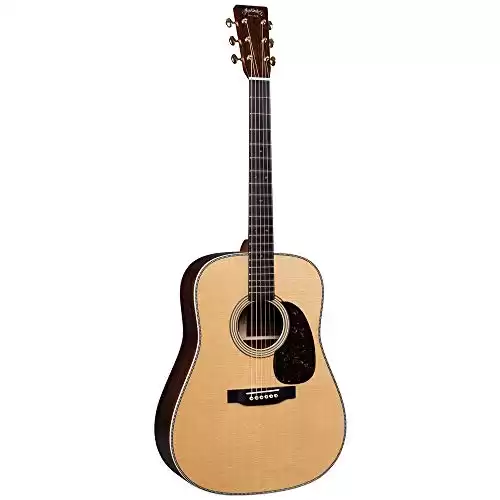Older acoustic guitars often came with an adjustable bridge. A great example of this design comes from Hohner, where you had screws on both sides to raise and lower it.
The goal of the adjustable design is that it makes it easier to get low action while playing. If you want something higher, you could make the necessary adjustments to create that result.
When you look at today’s acoustic guitars, almost none of them have an adjustable bridge. You can look at some of the most expensive Martins or the cheapest no-name kits and find the same result.
Why is it that acoustic guitars don’t come with adjustable bridges like they did in the past?
Why Are There so Few Acoustics with Adjustable Bridges?
Adjustable bridges are not typically found on modern acoustic guitars because the extra hardware weight deadens the instrument’s tone. Anything that muffles the instrument’s soundboard can create sustain issues, dull notes, and chord shaping problems to deliver an inferior playing experience.
Although Hohner used an adjustable bridge on their acoustics to great acclaim, they weren’t the only manufacturer to give this design a try.
Epiphone, Gibson, Vox, and several others have instruments that let you change the action of the strings.
The issue with the design is that the saddle doesn’t come into complete contact with the strings. That means the vibration transfer becomes inefficient, creating more hollowness to each note and sound.
Hohner had some success with their design because the saddle sits within a metal channel on the instrument. Two screws support it, going into the bridge, to transfer the vibrations to the tonewood.
With that design, the routed slot in the bridge is much broader, which means any adjustments would require an entire update.
You’ll also find the design on older acoustics for a practical reason. When the instruments were coming out in the 1940s and 1950s, purchasing more than one guitar wasn’t always possible.
That means one piece was needed to accommodate multiple playing styles. The manufacturers that could produce that flexibility were the ones that could attract more sales.
Gibson and Epiphone continued using the design through the 1970s. Although some people don’t like them, the guitar gets a woody, quiet sound to it that works well for some musical genres.
Facts to Know about Guitar Bridges
When you think about the tone chain for the guitar, the bridge ranks with the pickups and the body as essential ingredients for a great playing experience.
A high-quality bridge is essential if you want an instrument to offer a harmonically rich resonance with deep frequencies and prolonged sustain.
When taking a closer look at the qualities a bridge offers to an acoustic instrument, it becomes easier to see why adjustable bridges are no longer part of the design process.
1. Bridges Are Anchors
Acoustic guitars require solidarity. When the strings reach the bridge, they need a consistent termination point to produce the notes and sounds required.
The vibration passes through the bridge to reach the tonewood. If you can make adjustments to that part, the manufacturer would be unable to guarantee the instrument’s sound quality.
2. Tension Changes
Acoustic guitars require consistent tension across the soundhole to ensure the correct notes and chords ring out to the listener. When the bridge can be adjusted in different ways, this feature can change unpredictably.
If you have a rocker-style bridge installed on your guitar, you could have a vibrato unit added to reduce string tension to improve tone.
For most players and listeners, anything that robs the instrument of its authentic sound is considered an undesirable modification. That means an adjustable bridge becomes unwanted.
3. Bridge Composition
Acoustic guitars need the bridge to transfer vibrations to the tonewood consistently. When the product is made from different materials, you’ll get changes to the overall sound.
A die-cast option sounds different than bone. Both have unique qualities when compared to stamped steel, nickel plating, or even chrome polish.
The acoustic guitars get designed with a bridge in the appropriate spot to maximize the sound quality already. It’s a tested feature where you automatically receive the best result possible.
4. Tuning Problems
Adjustable elements for a guitar’s intonation can create tuning problems when the bridge can move a little, even if the screws can tighten.
Some instruments never quite get to where they need to be because even tiny changes alter the entire profile.
When the added weight of an adjustable bridge contributes to the sound shaping, it’s possible to get a deadened tone without the appropriate tuning.
That’s why some instruments always seem to be a little off, even when everything gets set appropriately.
5. Feel Changes
The guitar’s bridge is a crucial element in determining how the instrument feels when played. Even when the tension is the same, different units can feel loose, tight, spongy, or strung out. If these features are adjustable, it could become an unplayable experience for anyone but an experienced musician.
Does an Adjustable Bridge on an Acoustic Deliver Any Advantages?
When an acoustic guitar has an adjustable bridge, the temptation is to focus on the disadvantages of that idea.
The truth is that you can find some benefits to consider, especially when using an updated design.
- The modern adjustable bridge for an acoustic guitar looks about the same as a traditional one. Most people wouldn’t be able to tell the differences between them visually.
- You can retrofit some new adjustable designs to existing instruments to experiment with this option.
- Additional contact points are now available to transfer more vibrations to the tonewood for excellent volume and sustain.
An invention in 1990 allowed for an adjustable bridge system with movable individual saddles, creating a toothed bottom with an engaged base plate. Another in 2005 used slanting slots within the saddle blocks at the desired location to create different action.
If you feel like the action is too high, you can always file the bridge down a little. A luthier might be needed to complete that job.
When you want multiple choices, a great guitar can deliver the results you want.
What Is the Best Acoustic Guitar to Play Today?
If you’re interested in playing an acoustic guitar that can meet all your needs, I highly recommend the Martin D-28.
This deluxe acoustic guitar is made with Sitka spruce and East Indian rosewood, offering a vintage look with a high-performance taper.
The first strum delivers a professional sound with aged consistency, providing a robust tone to any composition.
What I like the most about this instrument is the carbon fiber bridge plate. This feature amplifies the sound naturally, ensuring that each listener can hear the deep bass tones while enjoying the brightness of the Sitka.
This guitar isn’t a mass-produced product banking on a brand name to charge extra. It’s a premier handmade instrument built with the best wood available.
It stands up to almost any playing need, ranging from a long recording session to playing a gig in a smoky bar.
Not only does it deliver the iconic Martin tone, but it also provides excellent playability for any genre. It sounds fantastic when playing jazz, country, rock, and more.
It might be an investment to get this guitar, but the price is fair for what you receive. If you can give it a few weeks to get to know your playing style, the results will blow your mind.
A Final Thought on Acoustic Guitars and Adjustable Bridges
Adjustable saddles let players raise or lower the guitar’s action to fit a specific playing style. That means a fingerpicker, flatpicker, or a shredder could all play the same instrument with this design feature. Although the concept is appealing, the impact on tone can be severely negative.
Some people love the quieter sounds that come from guitars with an adjustable bridge. I’ve found that some of the older instruments tend to deliver the best results.
If you listen to 1960s acoustic rock, you’ll hear the benefits of this feature being played in a group setting.
An adjustable bridge on an acoustic guitar is also worth considering for players who love chasing different tones.
The decision as to whether this feature should be used is a personal choice. I’d avoid it personally unless there’s a modified natural saddle with bone inserts. Those elements create an authentic tone that I find very appealing.
If you love acoustic sounds with metallic overtones, an adjustable bridge makes sense. When you want something with twang and edge, you’ll want to go without.


